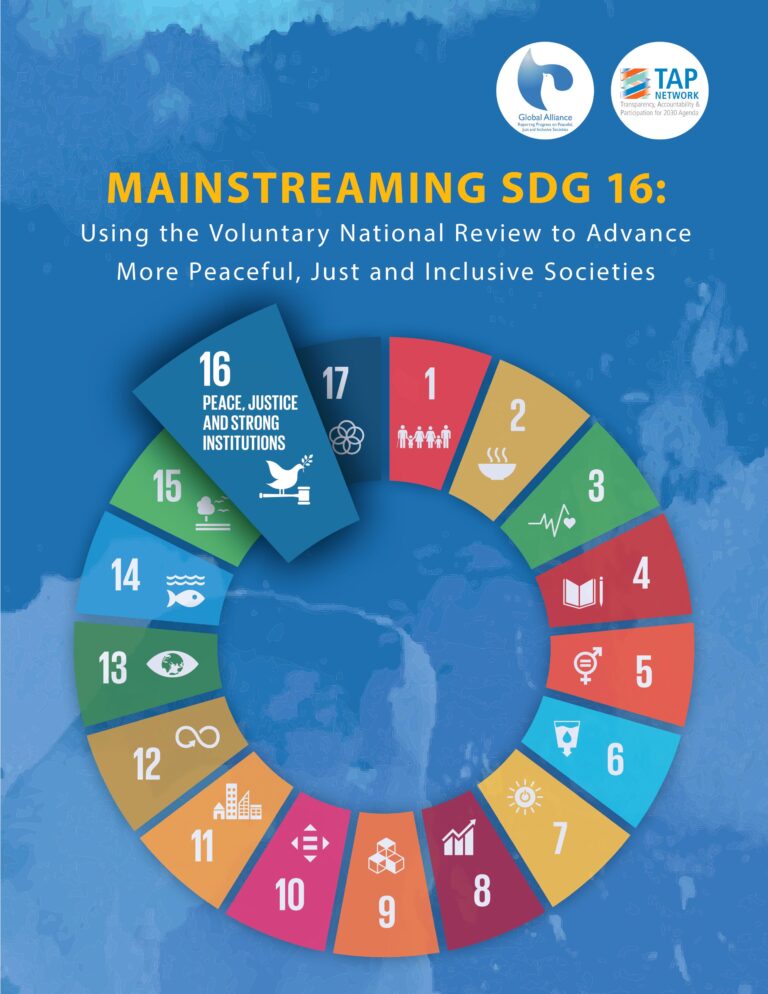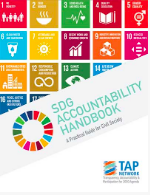National budgets are a government’s most powerful economic tool to meet the needs of its people and essential to both SDG16+ implementation and accountability
The national budget is a financial statement presenting the government’s proposed revenues and spending for a specific period of time – usually a year – which is often passed by the legislature, approved by the head of government and presented by the finance minister to the nation. National budgets are a government’s most powerful economic tool to meet the needs of its people, especially those most at risk of being left behind. As a political expression of the decisions of the executive government to raise revenues and allocate public resources, it is an integral part of national development strategies, with wide-reaching impacts across both the economy and society.1 In most countries, the budget process occurs in the following four stages: budget formulation; budget approval; budget execution; and budget oversight.

National budgets are fundamental to advancing peaceful, just and inclusive societies. The most well-intentioned public policies and plans for SDG16+ implementation will have little impact unless they are matched with sufficient public resources for effective implementation. Budget systems that are transparent, inclusive and monitored through strong independent oversight institutions are at the heart of SDG target 16.6 (effective, accountable and transparent institutions)2 and the best way to manage public funds efficiently and equitably. Conversely, a lack of transparency and limited public participation and oversight in budgeting processes undermine fiscal discipline, reduce the efficiency of public services and create opportunities for corruption (undermining SDG target 16.5) and other leakages.
Budgets are also critical to translate SDG16+ commitments on inclusion and non-discrimination into concrete action. For example, gender-responsive budgeting tools can be used to ensure that women and girls receive an equitable proportion of the national budget to meet their needs and rights. Budget-based approaches to tackle discrimination include conducting targeted interventions, mainstreaming public services, and monitoring the impact of budget programs on specific groups of the population who are at risk of being left behind.3
Ideally, all countries should link or align their national budgets to the SDGs – including SDG16+ – in order to ensure that public spending reflects sustainable development priorities.4 While some countries are in the process of incorporating SDG programs into their budget planning processes and aligning their budgets with the SDGs,5 national efforts to link budget processes with the SDGs have, thus far, been limited in both developed and developing countries.6
Participatory budgeting to support SDG16+ implementation7
Participatory budgeting is a decision-making process in which citizens and community members work closely with their government to determine how part of the public budget is spent. It is a reflection of both SDG targets 16.6 (effective, accountable and transparent institutions) and 16.7 (responsive, inclusive, participatory and representative decision-making). Through participatory budgeting, citizens can prioritize spending on public resources and influence local or national policy, making it an innovative and powerful tool for inclusive, participatory and accountable governance. Starting in Brazil in 1989, more than 1,500 participatory budgets have been implemented globally. In Indonesia, for example, where the SDGs are integrated into national and subnational development planning, the “Village Law,” enacted in 2014 has opened up the possibility for participatory budgeting in the country’s 74,000+ villages. This law mandates the central government to provide a specific amount of funding to villages to finance their own development based on local need and priorities.
CSOs can play a critical role in government budget processes for SDG16+ implementation and accountability. They can inform the decision-making process to ensure that public resources for SDG16+ implementation are sufficient and being used effectively, and they can monitor the actual execution of budget policies and programs to hold governments accountable.8 In seeking to engage in the budget process, you should consider taking the following actions:
a. Budget formulation stage:14
b. Budget approval stage:16
c. Budget execution stage:18
d. Budget oversight:19
Case Study


Case Study
Aligning Strategic Frameworks and Engaging Budget Officials20
SDG Accountability Handbook
The implementation of the SDGs in Tanzania falls under the Five-Year Development Plan II (FYDP II) framework, requiring local authorities to integrate the Goals in their strategic plans. To ensure local authorities were familiar with the SDGs and aligned the FYDP II with their strategies, the Local Governance Working Group of Policy Forum, an NGO Network, developed a policy brief and engaged with the Parliamentary Committee for Administration and Local Government. The brief focused on the Ministry of Regional Administration and Local Government (PO-RALG), analyzing budget allocation trends in relation to the implementation progress of SDGs, particularly Goal 3 (good health and wellbeing) and Goal 4 (quality education). The analysis further looks at the budget allocation trends within the Ministry of Health, Community Development, Gender, Elderly and Children (MoHCDEC), and the Ministry of Education, Science and Technology. Through their engagement, the Policy Forum was able to identify champions to promote the SDG agenda during parliamentary discussions and also organize a strategic session with PO-RALG management to promote better SDG and FYDP II alignment. In addition, the network collaborated with the Tanzania Sustainable Development Platform to train PO-RALG management and other staff on the FYDP II, Agenda 2063, the 2030 Agenda and the SDGs. As a result of such training and engagement, PO-RALG staff and councilors have a better understanding of the alignment between the SDGs and development plans, as well as the budget process, resource management and value for money.21
Mainstreaming SDG 16: Using the Voluntary National Review to Advance More Peaceful, Just and Inclusive Societies (Global Alliance and TAP Network, 2020)
This resource provides policy guidance, case studies and good practices on advancing SDG 16 implementation at national and subnational levels by more effectively leveraging the Voluntary National Review (VNR) and post-VNR processes. It discusses national budgets, including how they can be aligned with the SDGs.
Available at: https://www.sdg16hub.org/topic/mainstreaming-sdg-16-using-voluntary-national-review-advance-more-peaceful-just-and-inclusive

SDG Accountability Handbook: A Practical Guide for Civil Society (TAP Network, 2018)
This handbook provides guidance on the different approaches and steps that can be taken by civil society to ensure national government accountability for the SDGs. It includes a chapter on ‘Utilizing National Budgets or National Public Finance Systems.’
Available at: https://sdgaccountability.org/

These guides and toolkits aim to provide accessible, practical guidance for understanding and applying skills, tools and methodologies for budget analysis, monitoring and advocacy.
Available at: https://www.internationalbudget.org/capacity-building/guides-toolkits/
This section of the website of the International Budget Partnership allows users to search for budget-related publications by keyword, country and subject.
Available at: https://www.internationalbudget.org/library/publications/
This index is the world’s only independent, comparative measure of central government budget transparency. It is based on the Open Budget Survey, which assesses the amount and timeliness of budget information that governments make publicly available in eight key budget documents in accordance with international good practice standards.
Available at: https://www.sdg16hub.org/node/1035
This guide offers an overview of government budget implementation processes and provides practical, tested tools that can be used by civil society organizations interested in monitoring government expenditures. Available in English, French, Spanish, Russian, Chinese and Bahasa Indonesian.
Available at: https://www.internationalbudget.org/publications/our-money-our-responsibility-a-citizens-guide-to-monitoring-government-expenditures/
This guide provides a comprehensive description of the basic principles of applied budget work, examples of useful resources and best practices. It provides a systematic overview of the different aspects of effective budget analysis, with an emphasis on the activities and approaches a NGO might want to undertake in its initial years of budget work. Available in English, French, Spanish, Arabic and Russian.
Available at: https://www.internationalbudget.org/publications/a-guide-to-budget-work-for-ngos/
This guide provides essential information on how civil society organizations can use, and have used, the eight key budget reports that their government should be making available throughout the budget process for research and advocacy purposes. Available in English, French, Spanish, Portuguese and Arabic.
Available at: https://www.internationalbudget.org/publications/guide-to-transparency-in-government-budget-reports-how-civil-society-can-use-budget-reports-for-research-and-advocacy/
This report examines national-level developments in relation to several concepts of SDG 16, including access to information, transparency, accountability, anti-corruption, inclusiveness of decision-making processes and non-discrimination. It includes a detailed chapter on how budget processes can be harnessed to better support the implementation of the 2030 Agenda and the SDGs.
Available at: https://publicadministration.un.org/en/Research/World-Public-Sector-Reports
This brief explores good practices and lessons learned from monitoring government budgets and expenditure on the Millennium Development Goals (MDGs) that can assist with monitoring, reporting, and accountability in respect of the SDGs. It features summaries of case studies from 11 countries.
Available at: https://www.internationalbudget.org/publications/tracking-spending-sustainable-development-goals/
This paper explores the potential of participatory budgeting for contributing to the achievement of the SDGs. It looks at how participatory budgeting is contributing to the achievement of SDG 16 and provides specific recommendations for action, based on innovative practice examples from around the world, highlighting how practice across diverse local authorities could be used to monitor SDG target 16.7.
Available at: https://www.researchgate.net/publication/335948749_The_contribution_of_participatory_budgeting_to_the_achievement_of_the_Sustainable_Development_Goals_lessons_for_policy_in_Commonwealth_countries
This resource introduces the concept of participatory budgeting and provides an overview of the opportunities and challenges that the implementation of such a model can bring. It presents examples of governments that have conducted participatory budgeting processes successfully and includes examples of tools and platforms that they have used. Available in English, Spanish and Portuguese.
Available at: https://library.theengineroom.org/participatory-budgeting/
This book provides an overview of the principles underlying participatory budgeting. It analyzes the merits and demerits of participatory budgeting practices around the world with a view to guiding policy makers and practitioners on improving such practices in the interest of inclusive governance. It includes five regional surveys and seven country case studies. Available in English and Chinese.
Available at: https://documents.worldbank.org/en/publication/documents-reports/documentdetail/635011468330986995/participatory-budgeting
Transparency, Accountability &
Participation (TAP) Network
Address: 205 E 42nd St.
New York, NY 10017
Email:
[email protected]